



Extremadura,
Spain Travel & Accommodation Guide
Badajoz
Hotels, Extremadura, Spain
|



| BADAJOZ FEATURED HOTELS,
EXTREMADURA, SPAIN |
|

| Badajoz
- A city on the Guadiana
River near the Portugal border. In the province of Badajoz, bordering on
the north with Cáceres, on the south with Andalucía (the
provinces of Córdoba, Sevilla and Huelva), east with the lands of
Castilla La Mancha, and on the west with the neighboring lands of Alentejo
in Portugal. An ancient fortress city, it rose to prominence under the
Moors as the seat (1022–1094) of a vast independent emirate. |
 |
 Search
for hotels in Badajoz and surrounding areas
Search
for hotels in Badajoz and surrounding areas
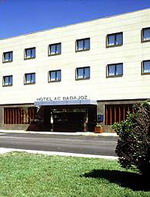 |
AC
Badajoz
The AC Badajoz is a low-rise
modern hotel with chic interiors located in the suburbs of Badajoz, five
kilometres from the buzzing nightlife of the city centre, and two kilometres
from the Portuguese border. The hotel restaurant serves a fusion of Spanish,
Portuguese and international tastes, served at breakfast and dinner in
a stylish eatery. Decor includes contemporary dark wood furniture, paneled
walls and olive green booths. Guests can combat the excesses of the
Spanish culinary experience in the fitness centre, or unwind in a decadent
Turkish bath or sauna. Six high tech conference rooms seating up to 102
people, accompanied by comprehensive business services, see to business
travellers' needs. In between meetings, guests can get their caffeine fix
in the ultramodern lobby lounge/café while they get up-to-date on
current affairs with complimentary newspapers and high-speed Internet connections
(surcharge). Badajoz Airport is 10 kilometres from the hotel. |
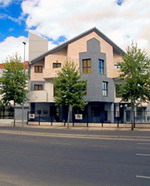 |
Badajoz
Center Hotel, Badajoz
The modern Hotel Badajoz
Center, with grey and peach-colored façade, is located in the shopping
and business district of Badajoz, 12 kilometers from the airport. The town's
cathedral and the fine art and modern art museums are all within one kilometer
of the hotel. Local dishes and international food is served in the
relaxed, contemporary ambience of the hotel's restaurant, with its brown
walls, table lamps and yellow chairs. The outdoor swimming pool is lined
with contemporary loungers and the solarium is the best spot for soaking
up some rays. A covered car park is available for guests arriving by car,
and six function rooms are provided for social events and conferences,
equipped with audio-visual equipment. The 88 air conditioned guestrooms
feature chic white décor with burgundy fanbrcis and crisp white
bedding; furniture is in contrasting dark wood. |
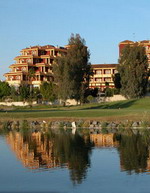 |
Confortel
Badajoz
This modern, white complex
is surrounded by the Guadiana golf course and is located three kilometers
from the center of Badajoz, in the region of Extremadura. Access can be
arranged to the Guadiana golf club next door, which has a gymnasium, sauna
and 18-hole golf course. Badajoz center has a variety of shopping and dining
options, only 3 kilometers away. In the restaurant, La Cazuela, guests
can try local and Mediterranean cuisine and a range of wines served in
a relaxed, informal atmosphere with a simple white décor and dark
wood furnishings. Guests can have a revitalizing dip in the outdoor
pool and play squash or tennis on clay courts. Conference rooms are available
for seminars and business meetings. Air-conditioned guestrooms feature
a simple white décor with rural-style dark-wood furnishings. All
rooms have work desks with complimentary wireless Internet access, private
bathrooms with handheld showers and complimentary minibars. |
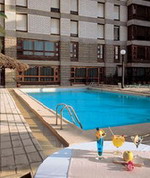 |
Hotel
Husa Zurbarán, Badajoz
The Husa Zurbaran is a five-floor
hotel situated in front of Castelar Park in the shopping centre of Badajoz
in south-western Spain, close to the Portuguese border. A number of tourist
attractions are within walking distance of the hotel including: the Art
Museum, which is 400 metres away; the Archaeological Museum, 700 metres
away; and Plaza Ayuntamiento Cathedral which is 800 metres from the hotel.
Further afield is the Lusiberia Aquatic Park which is 3.5 kilometres away.
Badajoz Airport is 12 kilometres from the hotel, an approximate driving
time of 15 minutes. The hotel's Los Monjes restaurant serves international
cuisine with regional specialties in a modern setting. Guests can soak
up the sun on the loungers, take a dip in the outdoor pool, and relax with
a drink in the bar. |
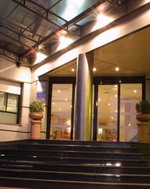 |
Sercotel
Rio Badajoz
The Hotel Rio Badajoz is
located on the banks of the Guadiana River in Badajoz, Spain, close to
the Portuguese border. The casino is next door, and the churches and squares
of the old town are 800 metres away. The Hotel has an outdoor pool with
a poolside bar. There is a mahogany bar and reading room, and secure parking
is complimentary. La Alacena Restaurant, with its mahogany-clad walls,
specialises in Portuguese cooking. There is a convention centre with
several meeting spaces, the largest of which can accommodate up to 1,000
persons. A babysitting service is offered at the hotel. There is
also a regular bingo night. The 101 air-conditioned guestrooms are
have modern Mediterranean decor, and carved dark wood furnishings. Amenities
include satellite television, direct-dial phones, Internet access, and
minibars. |
Search
for hotels in Badajoz and surrounding areas

| ZAFRA
FEATURED HOTELS (Badajoz Province) |
|

| Zafra
- One of the most interesting
stopovers in lower Extremadura, the white-walled town of Zafra is filled
with old Moorish streets and squares. The 1457 castle of the dukes of Feria,
the most important in the province, boasts both a sumptuous 16th-century
Herreran patio and the Sala Dorada with its richly paneled ceiling - this
building has now been converted into a Parador - details below. |
 |
 Search
for hotels in Zafra and surrounding areas
Search
for hotels in Zafra and surrounding areas
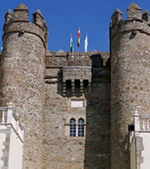 |
Parador
de Zafra, Zafra, Badajoz
The Hotel "Duque de Feria"
in Zafra occupies a majestic castle which was begun in 1437 as the residence
of the Dukes of Feria, one of Spain’s great families. The spectacular
façade expresses the importance of this castle-palace, which is
the ideal base for exploring the architectural heritage and the natural
beauties of the area. Nine towers with battlements stand guard over
a regal, grandiose interior which conserves beautiful coffered ceilings,
trunks, ironwork, balustrades and other decorative details from the former
palace. The bedrooms, which still have their ducal coffered ceilings
and decorative details, are lordly, elegant and spacious. The swimming
pool and well-tended garden are also worth a mention. The best local dishes
are offered in the dining room of the Parador de Zafra, such as caldereta
de cordero (lamb stew), migas extremeñas (breadcrumbs), bacalao
monacal (cod), zorongollo (tomato salad), cheesecake from La Serena, Iberian
pork loin with Ibores cheese, and, of course, ham. |
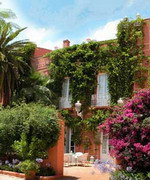 |
Rusticae
Casa Palacio Conde De La Corte, Zafra
This palace, in the heart
of the emblematic and majestic town of Zafra known as “mini” Seville, was
once the residence of Don Agustín Mendoza y Montero, Count of the
Court and owner of cattle of the same name. The interior patio is used
as a hallway leading to the different common areas and the breakfast room.
Another charming space is the garden with swimming pool with Victorian
style furniture creating different atmospheres. The rooms of
this hotel, taking inspiration from the world of bull fighting, are each
named after prestigious cattle rearing families. Spacious, they all convey
a classical, palatial feel with quality English style fabrics used for
the curtains and bedcovers. The large bathrooms with high ceilings are
colourful and original as is the shower that simulates a 19th century bird
cage. |


| The
Seige of Badajoz, Extremadura by Nick Nutter
Top -
Badajoz
Hotels
Unless you originate in the
vicinity of Nottingham in the UK it is unlikely that the word Badajoz will
do more than ring the odd bell in your memory, something you may have heard
at school perhaps. If just one incident had not occurred in 1812 that put
the name on everybody's lips, in Europe at least, it is likely that Badajoz
would have continued in obscurity, as it largely had since it was founded
by the Moors in the 9th century.
With interest peaked it is
time to visit this city that is situated on the Rio Guadiana, on the border
with Portugal, just two hours drive north of Seville in the neighbouring
community of Extremadura.
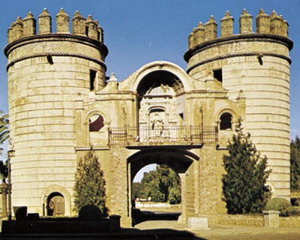 The
most powerful first impression of the city is gained if you approach the
city from the Portuguese side, which is strongly recommended due to the
vagaries of the city's ring road. You find yourself heading towards a fortress.
On the east side of the river is the city proper, surrounded by an immensely
strong wall, reminiscent of the fortifications at Gibraltar, with salients
jutting out at intervals. It is between two of those salients that the
road to the centre of the city takes vehicles via a modern bridge. If you
look to your left as you cross this bridge you will see a magnificent granite
bridge, built in 1460, repaired in 1597 and rebuilt in 1833, that crosses
the river to the original town gates, equally impressive, that penetrate
the walls on the east bank. Behind the gates is the hill on which Badajoz
was originally built, crowned by the Moorish fortress, incredibly still
largely intact. Beyond the granite bridge, on the west side of the river
is a hill on top of which is another fortress, that of the Fuerte de San
Cristobal. The adventurous can climb the hill and wander around this fort.
It is from here that you first start to appreciate the impregnability of
this city that owes its position to the strategic point it occupies on
the river from which it can guard one of the major trade routes to Portugal. The
most powerful first impression of the city is gained if you approach the
city from the Portuguese side, which is strongly recommended due to the
vagaries of the city's ring road. You find yourself heading towards a fortress.
On the east side of the river is the city proper, surrounded by an immensely
strong wall, reminiscent of the fortifications at Gibraltar, with salients
jutting out at intervals. It is between two of those salients that the
road to the centre of the city takes vehicles via a modern bridge. If you
look to your left as you cross this bridge you will see a magnificent granite
bridge, built in 1460, repaired in 1597 and rebuilt in 1833, that crosses
the river to the original town gates, equally impressive, that penetrate
the walls on the east bank. Behind the gates is the hill on which Badajoz
was originally built, crowned by the Moorish fortress, incredibly still
largely intact. Beyond the granite bridge, on the west side of the river
is a hill on top of which is another fortress, that of the Fuerte de San
Cristobal. The adventurous can climb the hill and wander around this fort.
It is from here that you first start to appreciate the impregnability of
this city that owes its position to the strategic point it occupies on
the river from which it can guard one of the major trade routes to Portugal.
Proof of the effectiveness
of the fortifications is the city's history. The Portuguese laid siege
to it in 1660 and the Brits tried to take it in 1705 during the War of
the Spanish Succession. During the Peninsula War, in 1808 and 1809, the
French unsuccessfully attacked Badajoz. The French only occupied the city
in 1811 when Marshal Soult bribed the Spanish commander, José Imaz
into surrendering. Soult's forces managed to hold out against a determined
British attack in the same year. It was left to Arthur Wellesley (later
Duke of Wellington) to ensure the name Badajoz entered the history books
for eternity in a battle that became known as 'The Siege of Badajoz'.
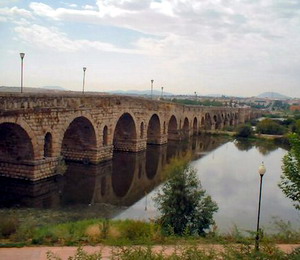 Wellesley
laid siege to the city in March 1812, bombarding the walls with iron shot.
Three weeks later there were three breaches in the wall. They were known
as practicable breaches if two infantrymen could pass through side by side.
On the inside of the walls 5,000 French soldiers prepared to repel the
Allied forces. Wellesley
laid siege to the city in March 1812, bombarding the walls with iron shot.
Three weeks later there were three breaches in the wall. They were known
as practicable breaches if two infantrymen could pass through side by side.
On the inside of the walls 5,000 French soldiers prepared to repel the
Allied forces.
The attack, by two British
and Portuguese divisions, about 25,000 men, began on the 6th April 1812
with a rush forward by a group of volunteers known as 'The Forlorn Hope'.
Their task was to put ladders against the walls and establish a bridgehead.
Not surprisingly their chances of survival were slim. For five hours wave
after wave of infantry tried to take the breaches supported by a diversionary
attack on the other side of the city. In the first two hours the British
and Portuguese troops suffered 2,000 casualties in the breaches and countless
wounded and dead at the site of the diversionary attack. They faced a barrage
of, in the words of one survivor, 'murderous musket fire, grenades, stones,
barrels of gunpowder with crude fuses and bales of burning hay '. The redcoats
had to struggle over the bodies of their fallen comrades. Wellesley was
on the point of recalling his decimated divisions when a foothold on the
walls was eventually gained. Sheer weight of numbers began to tell and
the French fell back to San Cristobal from where they eventually surrendered.
Over 5,000 Allied troops were killed or badly wounded in those five hours.
The first troops to enter
the fortress were from the 45th Regiment of Foot, later amalgamated with
the 95th to form the Sherwood Foresters. In the absence of a Union Flag,
Lt. James MacPherson had his red jacket hoisted up the flagpole to show
the castle had been taken. The event is commemorated at Nottingham where,
every 6th April, red jackets are flown on regimental flag staffs and over
Nottingham castle.
As often happened after a
particularly vicious battle, the survivors who had lost so many friends
and colleagues took revenge on the town. For 72 hours they looted, raped
and pillaged resulting in the deaths of about 4,000 Spanish inhabitants
and not a few officers who had tried to regain order. Order was only restored
after a few hangings and floggings. At dawn on the 7th April bodies were
piled high outside the city walls and blood flowed like rivers in the ditches
and streams. The Rio Guadiaro turned red. Wellesley is reported to have
wept and cursed the British Parliament for allowing him so few resources.
He wrote to Lord Liverpool,
"The capture of Badajoz affords as strong an instance of the gallantry
of our troops as has ever been displayed, but I anxiously hope that I shall
never again be the instrument of putting them to such a test as that to
which they were put last night"
His hopes were not fulfilled,
the siege of San Sebastian the following year was almost a carbon copy
of that at Badajoz.
It is not hard today to envisage
the scenes of 1812. The walls and bastions are largely still there. The
killing fields between the curtain walls and glacis are now public gardens.
A few modern buildings have arisen on the substantial walls but not enough
to detract from the awesome grandeur of the fortifications. It is difficult
to imagine the bravery of men on foot with muzzle loading rifles and muskets
throwing themselves against the vertical, grey, granite slabs.
Within the oldest part of
town, around the cathedral that is itself built like a fortress and within
the walls of the alcazabar the city is as it was 200 years ago. The few
British that reach Badajoz today are now made very welcome despite their
behaviour then.
Top
Badajoz
Hotels
|
| About the Author - Nick
Nutter is the editor of a magazine on the Costa del Sol, Andalucia
Life. |
|


|

